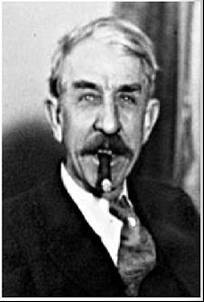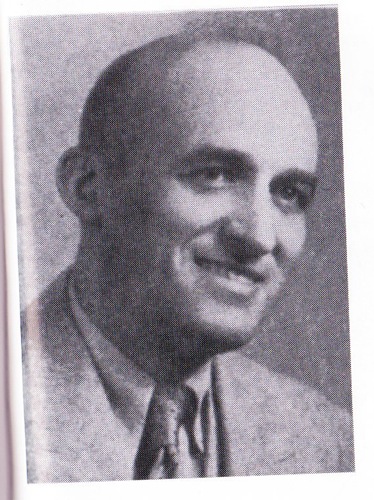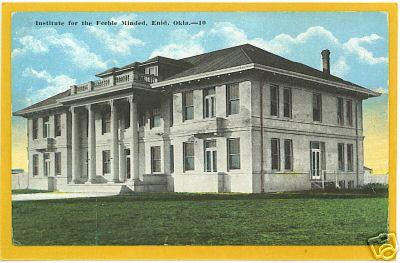Oklahoma
Number of victims
In
total, 556 individuals were sterilized in Oklahoma, of whom about 78% were
female. Almost half of them were considered “mentally deficient,” and the rest
were mentally ill. Oklahoma ranks 20th
among states in the United
States in terms of the total number of sterilizations. These numbers do
not include sterilizations of Native American women, of which there is
evidence base upon a GAO report from 1976 (see below).
Period during which sterilizations occurred
The
sterilizations began in the mid-1930s. The last sterilizations under
state law were
performed in 1955 (Paul, p. 453). Sterilizations of Native American
women, however, may have occurred as late as 1976 (Lawrence, p.
411).
Temporal pattern of sterilizations and rate of sterilization

Passage of law(s)
Legislation regarding sterilization in Okalahoma was first passed on April 22, 1931 (Landman, p. 93). Oklahoma was the 30th state in the United States to pass such a law. The law was expanded in scope in 1933 and in 1935.
Groups identified in the law
Sterilization
legislation in Oklahoma allowed for the sterilization of inmates of asylums,
prisons, and other state institutions who suffered from “cacogenic recurrent
insanity, idiocy, imbecility, feeble-mindedness, or epilepsy” (Paul, p. 450). It
also covered persons “afflicted with hereditary forms of insanity” (Nourse, p. 43).
In 1933, the law was expanded to cover patients “likely to be a public or
partial public charge” and “habitual criminal[s],” defined as “any person
convicted of a felony three times” (Nourse, p. 44). In 1935, the state passed
another law, the Habitual Criminal Sterilization Act, which held that those
found to be habitual criminals with two prior convictions could be forcefully
sterilized (Nourse, p. 84).
Process of the law
The
superintendent of a state institution could recommend an inmate for
sterilization. The superintendent then needed to seek affirmation of this
recommendation from the board of affairs.
At this meeting, the candidate for sterilization was permitted to
contest his or her recommendation. If,
at this meeting, the board did affirm the recommendation, the individual could
appeal this decision at the district court level and, eventually, at the level
of the State Supreme Court. The patient’s consent was needed in order to
complete the sterilization operation (Landman, p. 93). However, a patient
deemed a candidate for sterilization by the board of affairs and subsequent
court decisions was not permitted to leave the state institution without
undergoing said procedure (Nourse, p. 17).
For
those affected by the Criminal Sterilization law, writes Victoria Nourse in her
book In Reckless Hands, “the attorney
general…would be in charge of petitioning for sterilization, which would
require a jury trial and could be immediately appealed to the state supreme
court, bypassing intermediate courts. Gone were references to public charges
and social inadequacy [as in the 1931/1933 laws]; if the jury found that the
defendant was a habitual criminal and that sterilization would not harm his
health, then the district court was required to issue a sterilization order” (Nourse,
p. 84).
Legal Issues
As discussed by Victoria Nourse’s book (on which the following relies), the year 1942 brought the landmark decision of Skinner v. The State of Oklahoma, in which the United States Supreme Court ruled that forced sterilization was not a justifiable sentence for a crime. Because the compulsory criminal sterilization law in Oklahoma excluded white-collar crimes, the Supreme Court ruled that the punishment was altogether unjustifiable for any sort of crime. This was very significant in that sterilizations in the state decreased almost entirely after the ruling. It is important to note that the reason why sterilizations in Oklahoma decreased after the ruling was due largely in part to the fact that the vast majority of the sterilizations in Oklahoma were punitive. Therefore, the Supreme Court decision had outlawed the very kind of sterilization which was most prominent in the state. The ruling also had little effect on sterilizations nationwide. A great deal of sterilizations of the so-called “feeble-minded” occurred in the years after the ruling. Nourse posits that the main importance of this ruling lies in its triumph over the political and social climate of the time. Eugenics was a popular ideology in the nation at the time. A propaganda-induced moral panic had swept over the nation, causing much of the populous to believe that the human race was in grave danger of being overtaken by feeble-minded and habitual criminal “idiots.” Thus, it was neither easy nor particularly safe to stand as a voice of opposition against such a movement. That Skinner and his fellow inmates at McAlester Prison not only stood firm in their beliefs, but stayed the course all the way to the Supreme Court, was a very significant and often overlooked aspect of the fight against eugenics.
In an article regarding the sterilization of Native American women, Jane Lawrence highlights the importance of Skinner v. Oklahoma. It set a precedent by declaring the Oklahoma sterilization law unconstitutional under the Fourteenth Amendment. The judge, Justice William Douglas, stated “the power to sterilize, if exercised, may have far-reaching and devastating effects… [an in] evil hands it can cause races or types which are inimical to the dominant group to wither and disappear” (Lawrence, p. 404).
Precipitating factors and processes
 (Photo origin: Nourse, center section. Caption: Third International Eugenics Conference, 1932. Courtesy of Wellcome)
(Photo origin: Nourse, center section. Caption: Third International Eugenics Conference, 1932. Courtesy of Wellcome)
The
Great Depression created a new sense of urgency about public health. The ideas surrounding the perpetuation of
undesirable heredity were becoming less of a futuristic concern and more of a
present worry (Nourse, p. 23). Additionally, the general public became much
more concerned with criminality. The
growing presence of gangsters in the media fueled fears that society was
producing habitually criminal individuals (Nourse, p. 26). Directors of asylums
and prisons in Oklahoma claimed that their institutions were full to the point
of overflowing. They begged
then-governor Alfalfa Bill Murray to remove some of the burden that was being
placed on these institutions.
Sterilization offered a seemingly viable solution, as those
feeble-minded or otherwise desirable individuals could safely be released into
society after undergoing such a procedure (Nourse, p. 45).
Groups targeted and victimized
The
most widely targeted group in Oklahoma were criminals, particularly habitual
offenders. Murray was a firm believer in
the genetics of criminality, and argued that these individuals were a burden on
society that could be prevented by sterilization (Nourse, p. 20). Women were
also targeted more often than their male counterparts.
Native American Women may also have been the target of sterilizations, at least during the 1970s. In her book American Eugenics, Nancy Ordover reports that at the Indian Health Services hospital in Claremore, sterilization practices “translated into one woman sterilized for every four babies born at the facility” (p. 173) and quotes one investigator who, relying on native sources, states that there may well be “one tribe in Oklahoma where there are no full-blooded women who have not been sterilized” (p. 262 n. 58). Concern over the severity of such alleged practices has led some Native Americans to consider them genocidal.
Major proponents
 (Photo origin: OKGenWeb Project, available at http://www.okgenweb.org/~okalfalf/graphics/168px-William_Murray.jpg)
(Photo origin: OKGenWeb Project, available at http://www.okgenweb.org/~okalfalf/graphics/168px-William_Murray.jpg)
William Henry Davis “Alfalfa Bill”
Murray (1869-1956) was the governor of Oklahoma during the
emergence of the eugenics movement in the state. Murray was born in Texas and attended several
schools throughout the state. After
graduating from the College Hill Institute, Murray passed the bar exam and
began to practice law in Fort Worth.
Eventually, Murray moved his practice to Oklahoma. In 1907, Murray became the first Speaker of
the Oklahoma House of Representatives. In 1912, Murray was elected to the U.S.
House of Representatives. In 1930,
Murray was elected governor of Oklahoma. Gradually, Murray became a strong
proponent of the eugenics movement. He
was instrumental in the passage of legislation regarding sterilization (Nuarse,
pp. 20-22).
 (Photo origin: Nourse, center section. Caption: courtesy of Harper’s Weekly)
(Photo origin: Nourse, center section. Caption: courtesy of Harper’s Weekly)
“Feeder institutions” and institutions where sterilization were performed
 (Photo origin: Oklahoma Department of Corrections, available at http://www.doc.state.ok.us/photo/facilities/OSP.JPG)
(Photo origin: Oklahoma Department of Corrections, available at http://www.doc.state.ok.us/photo/facilities/OSP.JPG)

It is very difficult to determine where most of the sterilizations actually took place, or the feeder institutions that supply the groups of victims (mentally ill or “deficient”). An early commentary on the 1931 law provides excerpts from it, which include express references to the Hospital for the Insane at Norman (Central State Hospital, later Griffin Memorial Hospital), which began in the 1800s as a school for women, but in 1895 was sold to the Oklahoma Sanitarium Company. It functioned as a facility for the "violent insane" (Zizzo, p. 1). Norman State Hospital is also known for a devastating fire that occured in 1918, which resulted in 33 deaths (New York Times). It is no longer in operation, but in 1953, a short film was made by the University of Oklahoma, following the fate of a patient admitted to the Hospital for the Insane at Norman. The film was made with the intent to reveal the unfortunate circumstances of individuals admitted to mental hospitals. It offered a positive perspective on the reality of asylums and the work necessary to provide a “therapeutic environment” for patients. The film makes no mention of sterilizations or eugenics <http://www.asylumprojects.org/index.php?title=Norman_State_Hospital>.
Also referenced in the commentary on the law are the Hospital at [Fort] Supply (later Northwest Center for Behavioral Health at Fort Supply), the Hospital for the Insane at Vinita (later Easter State Hospital), and the Institute for Feeble Minded at Enid (later Enid State School, Northern Oklahoma Resource Center) (Brooks, p. 52).
 (Photo origin: http://okgenweb.org/~okcraig/history/craig_co/eaststhosp.html)
(Photo origin: http://okgenweb.org/~okcraig/history/craig_co/eaststhosp.html)The Hospital for the Insane at Vinita accepted its first patients in 1913, with a capacity of 600 patients (Drewery, p. 367). By the 1950s, the institution had a capacity of over 2,500 patients ("Eastern State Hospital"). It now operates as the Eastern State Hospital <http://okgenweb.org/~okcraig/history/craig_co/eaststhosp.html>
 (Photo origin: http://www.rootsweb.ancestry.com/~asylums/fortsupply_ok/index.html)
(Photo origin: http://www.rootsweb.ancestry.com/~asylums/fortsupply_ok/index.html)The Hospital at Fort Supply was established in 1908, and is known to have suffered 3 fires before 1916. It is believed to have been used for patients with chronic conditions and cases being treated "in connection with the insititution" in Norman (Drewery, p. 367). It is now known as Western State Hospital

Opposition
As
in many states, the Catholic Church was a strong oppositional force against the
eugenics movement (Nourse, p. 21). Additionally, in 1936, inmates at the
McAlester State Prison rioted against the law passed requiring forceful
sterilization of criminals. A “brain
trust” of prisoners formed in opposition to the laws. These men educated
themselves about the sciences of eugenics, preparing to fight the law in every
manner possible (Nourse, p. 49). Their leader,
Jack Skinner, became famous as the first test case for the third sterilization
law. His oppositions to the law led him
to district, state, and eventually the United States Supreme Court (Nourse, p.
92).
Bibliography
Brooks, Frank G. 1932. “The Oklahoma Sterilization Law and Its Application.” Proceedings of the Oklahoma Academy of Science 12: 52-54. Available at <http://digital.library.okstate.edu/oas/oas_pdf/v12/p52_54.pdf>.
Drewery, William Francis. 1916. The Institutional Care of the Insane in the United States and Canada. Baltimore: Johns Hopkins Press. Available at Google Books.
"Eastern State Hospital." OKGenWeb. Available at <http://okgenweb.org/~okcraig/history/craig_co/eaststhosp.html>
Landman, J. H. 1932. Human Sterilization: The History of the Sexual Sterilization Movement. New York: MacMillan.
Lawrence, Jane. 2000. “The Indian Health Service and the Sterilization of American Women.” American Indian Quarterly 24, 3.
New York Times. 1918. "33 Dead, 37 Missing, In Hospital Fire." 14 April.
Nourse, Victoria. 2008. In Reckless Hands: Skinner v. Oklahoma and the Near-Triumph of American
Eugenics. New York: Norton.
Ordover, Nancy. 2003. American Eugenics: Race, Queer Anatomy, and the Science of Nationalism.
Minneapolis: University of Minnesota Press.
Paul, Julius. 1965. “‘Three Generations of Imbeciles Are Enough’: State Eugenic Sterilization Laws in American Thought and Practice.” Unpublished manuscript. Washington, D.C.: Walter Reed Army Institute of Research.
Zizzo, David. 2011. "Norman Hospital once a 'mythical city.'" NewsOK Available at <http://places.newsok.com/hidden-oklahoma-norman-hospital-once-a-mythical-city/article/3546956>